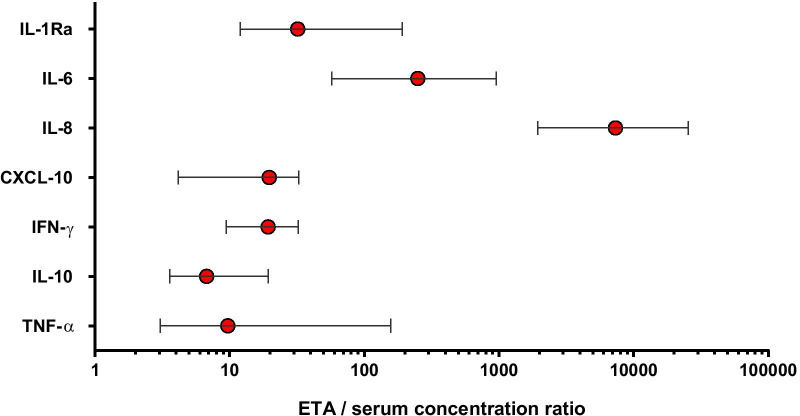Dear Editor,
We read with great interest the article of Bendib et al. published in Critical Care [1], in which they systematically assessed inflammatory mediators in pneumonia-related ARDS, both in airways and blood compartments. The authors observed a lung compartmentalization of inflammatory mediators, with important heterogeneity in the bronchoalveolar lavage fluid-to-serum concentration ratios across the mediators screened. The concept of compartmentalization of inflammation has already been formulated in pneumonia [2], and issues raised by assessing lung inflammation using blood inflammatory markers has also been highlighted, as well as the subsequent limitations of these biomarkers for bedside management [3]. However, we believe that it is critical to examine it further in ARDS, in this COVID-19 era. Indeed, since the beginning of the pandemic, most of the studies exploring immune dysregulation during COVID-19 were nevertheless based on data obtained only from blood, not because this is the most relevant compartment, but because it is the most easily accessible.
In complement to the work of Bendib et al., we evaluated coincident inflammatory mediators in blood and respiratory fluids (endotracheal aspirates [ETA]) of 21 critically ill COVID-19 patients with ARDS requiring mechanical ventilation, within 48 h of their admission in ICU. As observed by Bendib et al., we found an increased ETA-to-blood concentration ratio for IL-8, the cytokine for which concentration was the most compartmentalized to the lung. However, in our COVID-19 ARDS cohort, the median (quartile 1; quartile 3) ratio was highly elevated: 7355 (1959; 22433), compared to 20 in the study of Bendib et al. Moreover, ETA to blood concentration ratios of IL-1RA, IL-6, IFN-γ, TNF-α and CXL10 were also highly elevated (Fig. 1), at a higher level than those reported by Bendib et al. for ARDS without shock. Thus, during COVID-19-driven ARDS -and even compared to non-COVID-pneumonia-related ARDS- inflammation appears highly compartmentalized to the lungs. These results are in line with publications reporting relatively low levels of systemic inflammatory mediators compared to other conditions requiring ICU [4, 5]. Taken together, these data challenge the concept of “systemic cytokine-storm” that has been employed to describe immune dysregulation during severe COVID-19. Consequently, in our quest of identifying reliable biomarker in pneumonia-induced ARDS -whether COVID or not-, lungs should not be excluded.
Fig. 1.
Endotracheal aspiration (ETA)-to-serum concentration ratio of inflammatory biomarkers in COVID-19-related ARDS. Inflammatory mediators (IL-1Ra, IL-6, IL-8, IL-10, CXCL-10, IFN-γ, TNF-α) were measured in blood (serum) and supernatants of endotracheal aspirations with the Bio-Plex Pro Human cytokines panel (Bio-Rad) in a multiplex fluorescent bead assay (Luminex), according to the manufacturer’s instructions. The density ratio of endotracheal aspiration (g/mL) was 1:1. Circles and bars represent median values and interquartile range respectively
Acknowledgements
Not applicable.
Authors' contributions
YG, TB, MST, CP and AG were involved in drafting the manuscript. All authors read and approved the final manuscript.
Funding
No funding was used for this study.
Availability of data and materials
The datasets used and/or analyzed for this research letter are available from the corresponding author on reasonable request.
Ethics approval and consent to participate
All patients or their next of kin gave consent for participation in the study cited in this research letter. This work was part of an ongoing study exploring immune response during community-acquired pneumonia (ClinicalTrial.gov identifier: NCT03379207). The study was approved by the ethic committee “Comité de Protection de Personnes Ile-de-France 8” under the agreement number 2017-A01841-52, in accordance with the national laws.
Consent for publication
Not applicable.
Competing interests
No competing interests to declare.
Footnotes
Publisher's Note
Springer Nature remains neutral with regard to jurisdictional claims in published maps and institutional affiliations.
References
- 1.Bendib I, Beldi-Ferchiou A, Schlemmer F, Surenaud M, Maitre B, Plonquet A, et al. Alveolar compartmentalization of inflammatory and immune cell biomarkers in pneumonia-related ARDS. Crit Care. 2021;25:23. doi: 10.1186/s13054-020-03427-y. [DOI] [PMC free article] [PubMed] [Google Scholar]
- 2.Quinton LJ, Walkey AJ, Mizgerd JP. Integrative physiology of pneumonia. Physiol Rev. 2018;98:1417–1464. doi: 10.1152/physrev.00032.2017. [DOI] [PMC free article] [PubMed] [Google Scholar]
- 3.García-Laorden MI, Lorente JA, Flores C, Slutsky AS, Villar J. Biomarkers for the acute respiratory distress syndrome: how to make the diagnosis more precise. Ann Transl Med. 2017;5:283–293. doi: 10.21037/atm.2017.06.49. [DOI] [PMC free article] [PubMed] [Google Scholar]
- 4.Riva G, Nasillo V, Tagliafico E, Trenti T, Comoli P, Luppi M. COVID-19: more than a cytokine storm. Crit Care. 2020;24:1–3. doi: 10.1186/s13054-019-2683-3. [DOI] [PMC free article] [PubMed] [Google Scholar]
- 5.Kox M, Waalders NJB, Kooistra EJ, Gerretsen J, Pickkers P. Cytokine levels in critically Ill patients with COVID-19 and other conditions. JAMA. 2020;324:1565–1567. doi: 10.1001/jama.2020.17052. [DOI] [PMC free article] [PubMed] [Google Scholar]
- 6.Hue S, Beldi-Ferchiou A, Bendib I, Surenaud M, Fourati S, Frapard T, et al. Uncontrolled innate and impaired adaptive immune responses in patients with COVID-19 ARDS. Am J Respir Crit Care Med. 2020;202:1509–1519. doi: 10.1164/rccm.202005-1885OC. [DOI] [PMC free article] [PubMed] [Google Scholar]
- 7.Leisman DE, Ronner L, Pinotti R, Taylor MD, Sinha P, Calfee CS, et al. Cytokine elevation in severe and critical COVID-19: a rapid systematic review, meta-analysis, and comparison with other inflammatory syndromes. Lancet Respir Med. 2020;8:1233–1244. doi: 10.1016/S2213-2600(20)30404-5. [DOI] [PMC free article] [PubMed] [Google Scholar]
- 8.Convertino I, Tuccori M, Ferraro S, Valdiserra G, Cappello E, Focosi D, Blandizzi C. Exploring pharmacological approaches for managing cytokine storm associated with pneumonia and acute respiratory distress syndrome in COVID-19 patients. Crit Care. 2020;24:331. doi: 10.1186/s13054-020-03020-3. [DOI] [PMC free article] [PubMed] [Google Scholar]



